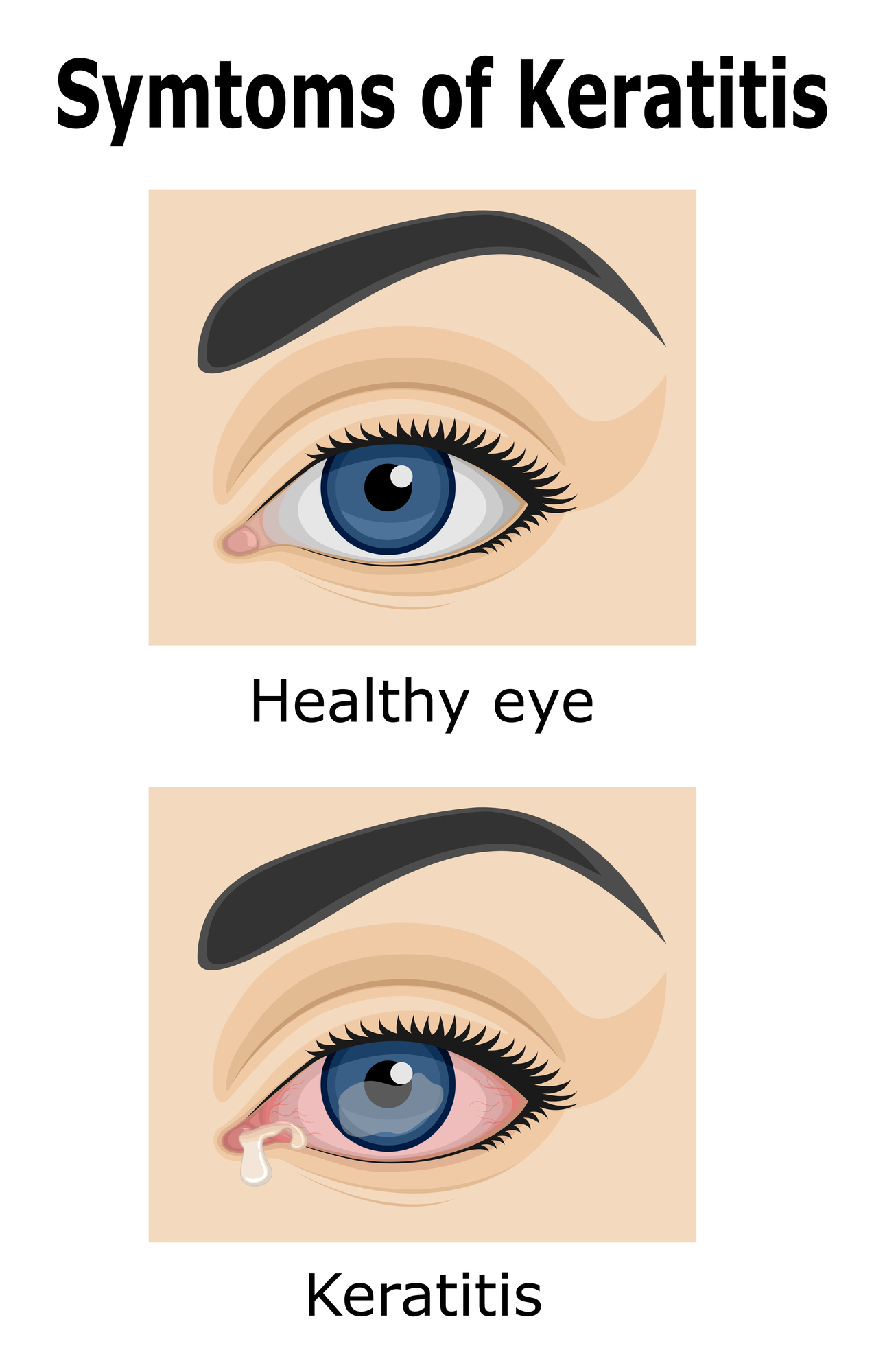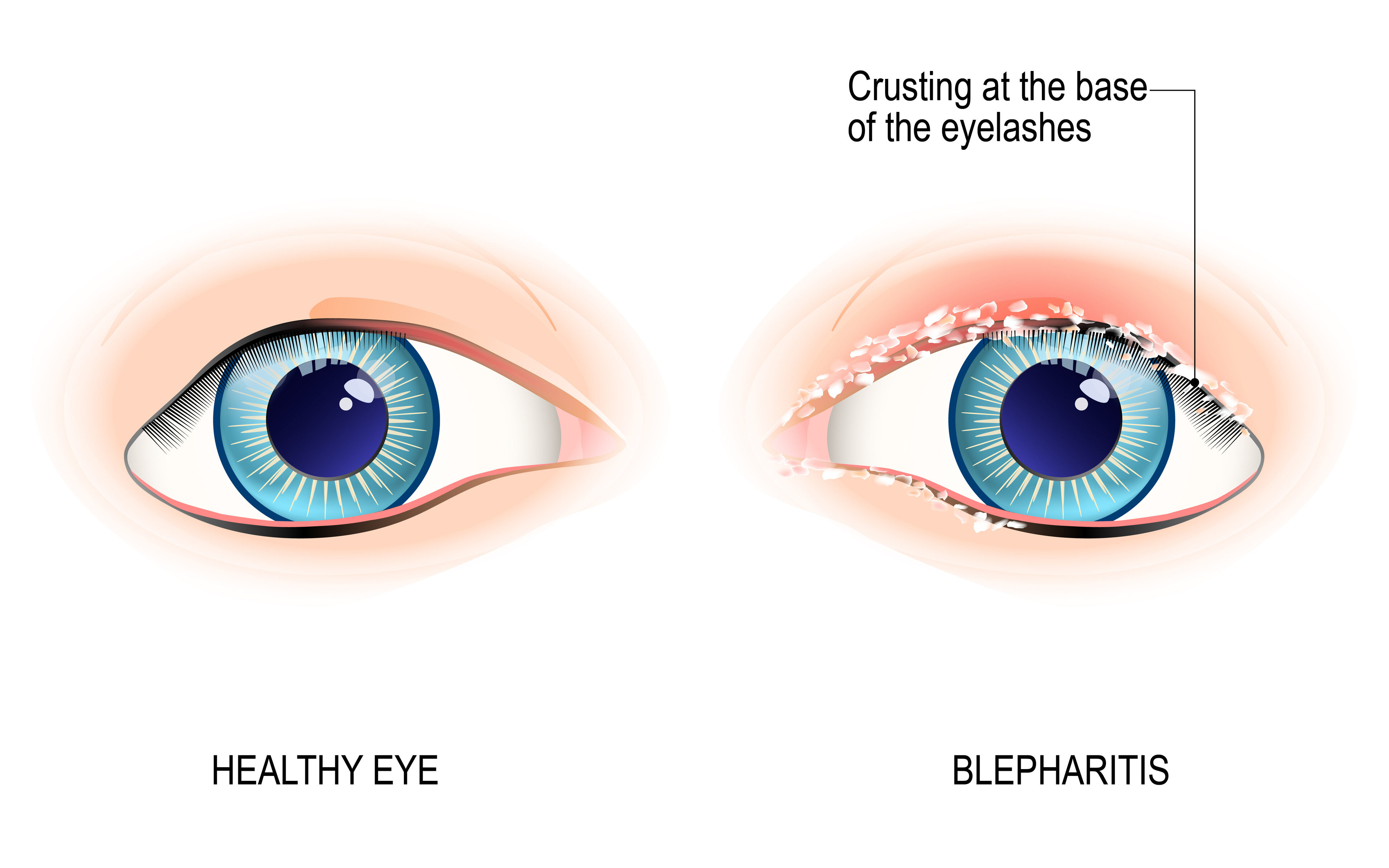Updated on May 6, 2025
Types of Eye Infections: Symptoms, Causes, & Treatment


Vision Center is funded by our readers. We may earn commissions if you purchase something via one of our links.
What are the Symptoms of an Eye Infection?
All types of eye infections usually share similar symptoms, including:
- Redness
- Eye pain
- Feeling like something is in your eye
- Sensitivity to light
- Blurry vision
- Watery eyes
However, some types of eye infections have specific symptoms that distinguish them from others.
- Discharge and pus are associated with bacterial eye infections.
- Vision changes are associated with keratitis, endophthalmitis, and cellulitis.
- Itchy eyes are associated with allergic conjunctivitis and uveitis.
Different Types of Eye Infections
Eye infections develop when viruses, bacteria, fungi, or other microbes enter the eye. Nearly a million people seek treatment for eye infections each year.1
While wearing contact lenses is a common cause of eye infections, they can also spread by rubbing our eyes and not washing our hands.
There are several different types of eye infections. Some infections are mild, while others can lead to visual changes and blindness if not treated.
Conjunctivitis (Pink eye)
Conjunctivitis is the inflammation of the membrane that lines the front of the eye and eyelid. It’s also known as pink eye and is the most common type of eye infection.

There are several types of conjunctivitis, including:
- Viral conjunctivitis
- Bacterial conjunctivitis
- Allergic conjunctivitis
- Gonococcal conjunctivitis
- Chlamydial conjunctivitis
Viral and bacterial conjunctivitis are both highly contagious and result in red eyes. Bacterial conjunctivitis is treated with antibiotic eye drops.
Since a virus causes viral conjunctivitis, it typically clears up in 7 to 14 days. Severe cases may be treated with steroids.
Allergic conjunctivitis is caused by exposure to allergens (pollen, dust, mold, pet dander) and leads to red, itchy eyes. Allergic conjunctivitis is not contagious.
Gonococcal and chlamydial conjunctivitis are less common and are caused by sexually transmitted diseases.
Keratitis
Keratitis is the inflammation of the cornea and is considered a medical emergency. If not promptly treated, keratitis can lead to corneal blindness.

Types of infectious keratitis include:
- Bacterial keratitis
- Herpes simplex keratitis
Bacterial keratitis is the most common type, often resulting from improperly cleaning contact lenses. Symptoms include redness, pain, and discharge. Bacterial keratitis is treated with topical antibiotics.
The herpes virus causes herpes simplex keratitis and commonly leads to blindness in developed countries. Symptoms include pain and decreased vision. It’s typically treated with oral antivirals and topical steroids.
Endophthalmitis
Endophthalmitis is the infection and inflammation of the tissue and fluid inside the eyeball. It is considered a medical emergency. Endophthalmitis can lead to blindness if not treated quickly.
The two types of endophthalmitis include:
- Exogenous endophthalmitis. This results from microbes (bacteria or fungi) entering the eye, often during eye surgery, eye injury, or eye injections.
- Endogenous endophthalmitis. This is when an infection from another place in the body spreads to the eye, most often in cases of urinary tract infections (UTIs) and blood infections.
Endophthalmitis is diagnosed by taking a sample of the eye’s fluid (vitreous tap). Treatment includes an antibiotic eye injection.
Cellulitis
Cellulitis is the inflammation and infection of the skin and tissue around the eyes. Bacteria and fungi are the typical causes of cellulitis migrating from insect bites, skin wounds, and sinus infections.
The two types of cellulitis include:
- Orbital cellulitis. Targets the eye socket (orbit), resulting in swelling and the inability to move the eye properly. Orbital cellulitis is more serious than preseptal cellulitis. It is treated with oral antibiotics but may need intravenous antibiotics in a hospital setting if it doesn’t improve.
- Preseptal cellulitis. Only affects the eyelid tissue and is treated with antibiotics. Preseptal cellulitis is most common in children. If left untreated, preseptal cellulitis can turn into orbital cellulitis.
Stye
A stye is the inflammation of oil glands near the eyelash line or on the eyelid. It typically looks like a red swollen pimple.

Styes are caused by a bacterial infection that blocks the eye’s sebaceous glands.
Apply a warm compress to the eye several times daily to promote drainage and healing. More severe cases might be treated with antibiotic eye drops.
Blepharitis
Blepharitis is eyelid inflammation, which leads to dandruff-like flakes and itchy eyes.

It is a common infection associated with allergy symptoms, oily skin, and rosacea (red, bumpy skin).
Blepharitis can lead to a stye and dry eyes. It is not contagious and is usually treated with a warm compress and steroid eye drops for more severe cases.
Uveitis
Uveitis is the inflammation of the uvea (middle layer of the eye), causing pain, blurry vision, and floaters.

While anyone can develop uveitis, it is commonly associated with autoimmune diseases such as:
- Lupus
- AIDS
- Multiple sclerosis
- Psoriasis
- Rheumatoid arthritis
Uveitis is usually treated using steroids to reduce inflammation.
Listen In Q&A Format
Eye Infections Types & Symptoms
Vision Center Podcast
Diagnosing and Treating Eye Infections
A medical professional diagnoses eye infections during a comprehensive eye exam. Diagnostic tools may include:
- Patient history
- Current symptoms
- Examination of the eye
- Taking a sample of eye fluid for testing (endophthalmitis)
The underlying cause of the eye infection will determine treatment.
Bacterial eye infections can be treated with antibiotic eye drops, oral antibiotics, or intravenous antibiotics for more severe cases.
Viral infections will typically clear up in about 7 to 14 days. Steroids or antiviral medication may also be used to reduce inflammation.
Fungal eye infections are usually treated with antifungal medication (oral, eye drops, intravenous) or may require eye surgery for severe cases.
Common, non-medication ways to relieve eye infection symptoms include:
- Placing a warm or cold compress over the eye several times a day
- Removing common allergy triggers (dust, pollen, pet dander)
- Rinsing your eyes with saline
- Placing cooled tea bags on your eyes to help reduce swelling
Tips for Preventing Eye Infections
The microbes (bacteria, viruses, fungi) that lead to eye infections surround us. They can easily be transferred from our hands to our faces after touching common, unsanitized surfaces (door knobs, countertops, shopping carts, school desks, etc.).
Tips for preventing eye infections include:
- Frequently wash your hands
- Avoid rubbing your eyes (especially with dirty hands)
- Clean your contact lenses daily following the manufacturer’s instructions
- Do not share items with an infected person (pillowcases, makeup, towels, etc.)
- Throw away makeup if you develop an eye infection
- Don’t wear contact lenses overnight
- Frequently wash your bedding and towels
- Avoid exposure to cigarette smoke
- Wash your face before bed
It is essential to seek medical attention if you are experiencing severe symptoms, including discharge, eye pain, and/or vision changes.
Summary
Eye infections are caused by microbes (bacteria, viruses, fungi) that enter our eyes, causing inflammation, swelling, redness, and blurry vision. Some types of eye infections are medical emergencies (keratitis and endophthalmitis).
Eye infections are commonly caused by improper cleaning of contact lenses and rubbing our eyes with dirty hands. Good ways to prevent eye infections include cleaning your contacts regularly, frequently washing your hands, and not sharing items with infected people.
In this article
7 sources cited
Updated on May 6, 2025
Updated on May 6, 2025
About Our Contributors
Amy, a registered nurse with an M.S. in Nursing from California State University, Sacramento, and a B.A. in Journalism from California State University, Chico, is a freelance health writer for Vision Center. Her unique combination of nursing knowledge and journalism skills enables her to educate readers about eye health effectively. Amy's goal is to merge her nursing experience with her writing talent to raise awareness about common eye conditions and ways to prevent vision loss.
Dr. Melody Huang is an optometrist and freelance health writer with a passion for educating people about eye health. With her unique blend of clinical expertise and writing skills, Dr. Huang seeks to guide individuals towards healthier and happier lives. Her interests extend to Eastern medicine and integrative healthcare approaches. Outside of work, she enjoys exploring new skincare products, experimenting with food recipes, and spending time with her adopted cats.

